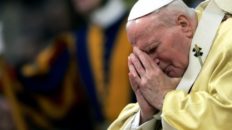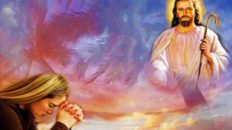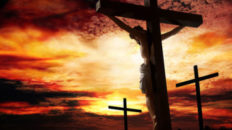Whether you believe in miracles or not, there is an enormous amount of documentation for seemingly inexplicable events over the centuries that many people believe to be the work of God Himself. In this list I have tried to pick the ten most interesting of these cases.
Here are 10 most Powerful and astonishing Catholic Miracles of all times
10. Marian Apparition in Zeitoun (1968 – 1970)

A Marian apparition is an event in which the Virgin Mary is believed to have supernaturally appeared to one or more persons regardless of their religious faith. They are often given names based on the town in which they were reported, or on the sobriquet which was given to Mary on the occasion of the apparition. They have been interpreted in psychological terms as pareidolia, and in religious terms as theophanies. Probably the most famous of these apparitions were the visions of St Bernadette at Lourdes (related item 6 on this list), and three children in Fatima (related item 1 on this list). In both cases, the people involved said that the Virgin Mary gave them predictions of future events and preached prayer and penance. The famous case of Our Lady of Zeitoun took place in Zeitoun, Cairo, and contrary to the norm, the apparition was witnessed by millions of people over a period of 2 to 3 years. The apparition was even caught on film (as seen in the photograph above). The Coptic Orthodox Pope of Alexandria in Cairo issued a statement that the apparitions were real. The Catholic Church has yet to issue an official statement. You can view video footage here.
9. Incorruptible Corpses

Incorruptibility is the name given to the situation in which a dead person does not decay after death. The orthodox church consider it essential in considering a person for canonization as a saint, and the Roman Catholic Church consider it as sign of sainthood but not a necessity. Additionally, the Catholic Church believes that a body is not deemed incorruptible if it has undergone an embalming process or other means of preserving the dead, or if it has become stiff, as do all normal corpses, even when the best preservation techniques are used. Incorruptible saints remain completely flexible, as if they were only sleeping. Incorruptible bodies are often said to have the Odour of Sanctity, exuding a sweet aroma. Over the years there have been hundreds of Saints whose bodies have been found to be incorrupt – some many hundreds of years after their death. In the image above we see St Bernadette as she appears today – 129 years after her death. For more astonishing pictures of incorruptible corpses (including the incorrupt body of St Silvan who died over 1,500 years ago), visit the Top 10 Incorrupt Corpses.
8. Therese Neumann (1896 – 1962)

Therese Neumann was a German Catholic mystic and stigmatic. On March 10, 1918, Therese Neumann was partially paralyzed after falling off a stool while attending to a fire in her uncle’s barn. She sustained more falls and injuries during this period. After one particular fall in 1919, she lost much of her eyesight. Therese reported that her eyesight was fully restored on April 29, 1923 — the day Therese of Lisieux was beatified (the first step to sainthood) in Rome. She said that on March 5, 1926, the first Friday of Lent, a wound had appeared slightly above her heart, but that she had kept this secret. However, she did report a vision of Jesus at Mount Olivet with three Apostles. On Easter Sunday, she claimed a vision of the resurrection of Christ. For several consecutive Fridays after that, she stated she was experiencing the Passion of Christ, supposedly suffering in her own body along with all his historic agonies. She especially suffered the Passion on Good Fridays each year. By November 5, 1926, she displayed nine wounds on her head as well as wounds on her back and shoulders (most of which are visible in the image above). According to several sources these wounds never healed or became infected and were found on her body at death. From the years of 1922 until her death in 1962, Therese Neumann said she had consumed no food other than The Holy Eucharist, and to have drunk no water from 1926 until her death. In July 1927 a medical doctor and four Franciscan nurses kept a watch on her 24 hours a day for a two-week period. They confirmed that she had consumed nothing except for one consecrated sacred Host a day, and had suffered no ill effects, loss of weight, or dehydration. Formal proceedings for her beatification were begun in 2005.
YOU MAY ALSO LIKE TO READ: Bishop Proclaims 70th Healing In Lourdes A Miracle
7. Statue in Akita (1973 – 1975)

In 1973, Sister Agnes Katsuko Sasagawa in Akita, Japan had visions of the Virgin Mary. On June 28, 1973, a cross-shaped wound appeared on the inside left hand of Sr. Agnes. It bled profusely and caused her much pain. On July 6, Sr. Agnes heard a voice coming from the statue of the Blessed Virgin Mary in the chapel where she was praying. The statue was carved from a single block of wood from a Katsura tree and is three feet tall. On the same day, a few of the sisters noticed drops of blood flowing from the statue’s right hand. The wound in the statue’s hand remained until September 29, when it disappeared. On September 29, the day the wound on the statue disappeared, the sisters noticed the statue had now begun to “sweat”, especially on the forehead and neck. Two years later on January 4, 1975, the statue of the Blessed Virgin began to weep. It continued to weep at intervals for the next 6 years and eight months. It wept on 101 occasions. Scientific analysis of blood and tears from the statute provided by Professor Sagisaka of the faculty of Legal Medicine of the University of Akita confirmed that the blood, tears, and perspiration are real human tears, sweat, and blood. They come from three blood groups: O, B, and AB. Sr. Agnes was also completely cured of total deafness. In June 1988, Cardinal Ratzinger (now Pope Benedict XVI) – head of the Office of Inquisition – judged the Akita events and messages as reliable and worthy of belief.
6. Lourdes (1858)

The apparitions of Our Lady of Lourdes began on 11 February 1858, when Bernadette Soubirous, a 14-year old peasant girl from Lourdes admitted, when questioned by her mother, that she had seen a “lady” in the cave of Massabielle, about a mile from the town, while she was gathering firewood with her sister and a friend. Similar appearances of the “lady” took place on seventeen further occasions that year. During one of the apparitions, she was directed by the “lady” to dig near a rock and drink from the spring there – there was a small puddle of mud in the place but as Bernadette dug in to it, a large spring appeared – this is the source of the water in the grotto to which millions of people flock for miraculous cures every year. The Lourdes Medical Bureau have declared 68 cases of inexplicable cures (out of thousands tested). You can read more on the scientific bureau here
5. Joseph of Cupertino (1603 – 1663)

Joseph of Cupertino is an Italian saint. He was said to have been remarkably unclever, but prone to miraculous levitation, and intense ecstatic visions that left him gaping. In turn, he is recognized as the patron saint of air travelers, aviators, people with a mental handicap, and weak students. He was canonized in 1767. On October 4, 1630, the town of Cupertino held a procession on the feast day of Saint Francis of Assisi. Joseph was assisting in the procession when he suddenly soared into the sky, where he remained hovering over the crowd. When he descended and realized what had happened, he became so embarrassed that he fled to his mother’s house and hid. This was the first of many flights, which soon earned him the nickname “The Flying Saint.” Joseph’s most famous flight allegedly occurred during a papal audience before Pope Urban VIII. When he bent down to kiss the Pope’s feet, he was suddenly filled with reverence for the Pope, and was lifted up into the air. He experienced ecstasies and flights (witnessed by thousands) during his last mass which was on the Feast of the Assumption 1663. Apple Inc.’s headquarters are in the California town of Cupertino, which was named after this saint. A film (the Reluctant Saint) was made about St Joseph – you can see a small clip of it at youtube (warning: it contains some serious over-acting – but has some humor too). [Source]
4. Tilma of Juan Diego (1474 – 1548)
![]()
Saint Juan Diego Cuauhtlatoatzin was an indigenous Mexican who reported an apparition of the Virgin Mary as Our Lady of Guadalupe in 1531. He had a significant impact on the spread of the Catholic faith within Mexico. According to Juan Diego, he returned home that night to his uncle Juan Bernardino’s house, and discovered him seriously ill. The next morning December 12, Juan Diego decided not to meet with the Lady, but to find a priest who could administer the last rites to his dying uncle. When he tried to skirt around Tepeyac hill, the Lady intercepted him, assured him his uncle would not die, and asked him to climb the hill and gather the flowers he found there. It was December, when normally nothing blooms in the cold. There he found roses from the region of Castille in Spain, former home of bishop Zumárraga. The Lady re-arranged the roses carefully inside the folded tilma that Juan Diego wore and told him not to open it before anyone but the bishop. When Juan Diego unfolded his tilma before the Bishop roses cascaded from his tilma, and an icon of Our Lady of Guadalupe was miraculously impressed on the cloth, bringing the bishop to his knees. The bishop acknowledged the miracle and within two weeks, ordered a shrine to be built where the Virgin Mary had appeared. The original tilma (pictured above) is on display in Guadalupe today and is one of the most frequently visited pilgrimage sites in the world. [Source]
YOU MAY ALSO LIKE: If You Say this Short Simple but Powerful Prayer… Jesus Will Surprise You with a Miracle.. DO IT NOW
3. Padre Pio (St Pio of Pietrelcina) 1887 – 1968

Francesco Forgione, later known as Padre Pio, canonized as Saint Pio of Pietrelcina, was an Italian Roman Catholic Capuchin priest who is now venerated as a saint in the Roman Catholic Church. He was given the name Pio when he joined the Order of Friars Minor Capuchin, and was popularly known as Padre Pio after his ordination to the priesthood. He became famous for his stigmata. Based on Padre Pio’s correspondence, even early in his priesthood he experienced less obvious indications of the visible stigmata for which he would later become famous. Though Padre Pio would have preferred to suffer in secret, by early 1919, news about the stigmatic friar began to spread in the secular world. Padre Pio’s wounds were examined by many people, including physicians. People who had started rebuilding their lives after World War I began to see in Padre Pio a symbol of hope. Those close to him attest that he began to manifest several spiritual gifts including the gifts of healing, bilocation, levitation, prophecy, miracles, extraordinary abstinence from both sleep and nourishment (One account states that Padre Agostino recorded one instance in which Padre Pio was able to subsist for at least 20 days at Verafeno on only the Eucharist without any other nourishment), the ability to read hearts, the gift of tongues, the gift of conversions, and the fragrance from his wounds. Rather than using an image, I have used a video clip of St Pio – you can see his hands concealed by fingerless gloves to hide his stigmata. You may also be interested in this clip in which St Pio’s grave and coffin are opened (on March 3, 2008) revealing that his body is incorrupt. His body is now on display in San Giovanni Rotondo. [Source]
2. The Miracle of Lanciano (700 AD)

In the city of Lanciano, Italy, around A.D. 700, a Basilian monk and priest was assigned to celebrate the Eucharistic sacrifice in the Latin Rite in the small Church of St.Legontian. Usually celebrating in the Greek Rite and using leavened bread and having been taught that unleavened bread was invalid matter for the Holy Sacrifice he was disturbed to be constrained to use unleavened bread and had trouble believing that the miracle of transubtantiation would take place with unleavened bread. During the Mass, when he said the words of consecration, he saw the bread change into live flesh and the wine change into live blood, which coagulated into five globules, irregular and differing in shape and size. Various ecclesiastical investigations have been conducted upon the miracle, and the evidence of the miracle remains in Lanciano to this day. In 1970-71, Professors from the University of Siena conducted a scientific investigation into the miracle. They concluded that the flesh and blood are human flesh and blood. The Flesh is a heart complete in its essential structure. The Flesh and the Blood have the same blood type, AB, which is also the same blood type found on the Shroud of Turin and all other Eucharistic Miracles. The Host-Flesh, which is the same size as the large Host used today in the Latin Church, is fibrous and light brown in color, and becomes rose-colored when lighted from the back. The Blood consists of five coagulated globules and has an earthly color resembling the yellow of ochre. [Source]
1. The Miracle of the Sun

The Miracle of the Sun is an alleged miraculous event witnessed by as many as 100,000 people on 13 October 1917 in the Cova da Iria fields near Fátima, Portugal. Those in attendance had assembled to observe what the Portuguese secular newspapers had been ridiculing for months as the absurd claim of three shepherd children that a miracle was going to occur at high-noon in the Cova da Iria on October 13, 1917. According to many witness statements, after a downfall of rain, the dark clouds broke and the sun appeared as an opaque, spinning disk in the sky. It was said to be significantly less bright than normal, and cast multicolored lights across the landscape, the shadows on the landscape, the people, and the surrounding clouds. The sun was then reported to have careened towards the earth in a zigzag pattern, frightening some of those present who thought it meant the end of the world. Some witnesses reported that their previously wet clothes became “suddenly and completely dry.” Estimates of the number of witnesses range from 30,000-40,000 by Avelino de Almeida, writing for the Portuguese newspaper O Século, to 100,000, estimated by Dr. Joseph Garrett, professor of natural sciences at the University of Coimbra, both of whom were present that day. The miracle was attributed by believers to Our Lady of Fátima, an apparition of the Blessed Virgin Mary to three young shepherd children in 1917, as having been predicted by the three children on 13 July, 19 August, and 13 September 1917. The children reported that the Lady had promised them that she would on 13 October reveal her identity to them and provide a miracle “so that all may believe.” The event was officially accepted as a miracle by the Roman Catholic Church on 13 October 1930. In the image above you can see some of the many witnesses photographed during the event. [Source]
YOU MAY ALSO LIKE
Top 10 Incorrupt Corpses (POWERFUL CATHOLIC SAINTS)
VIDEO: St. Joseph Was Also In The Miracle Of The Sun Of Fatima And This Is Its Meaning
The Holy Cross Miracle Prayer…..Very Powerful
Amazing Coincidence or Proof? All Major Relics of Christ Have the Same Blood Type
Miracle Prayer To Mother Mary To Help Solve Difficult And Impossible Situations



